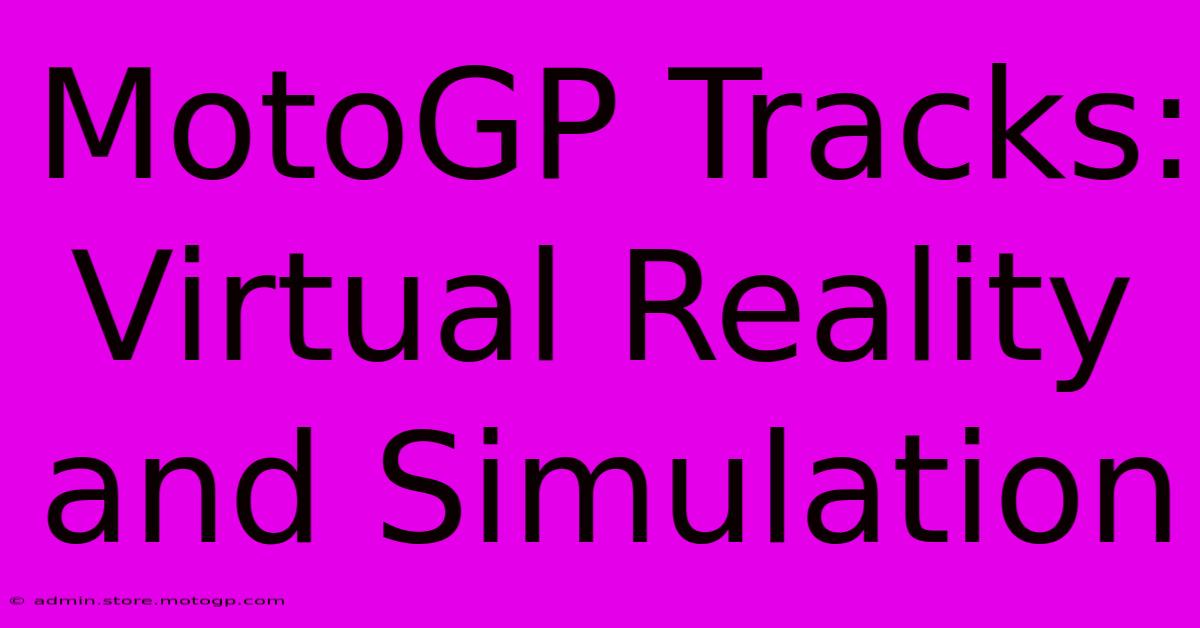MotoGP Tracks: Virtual Reality And Simulation

Table of Contents
MotoGP Tracks: Virtual Reality and Simulation - A New Era of Racing
The roar of the engines, the smell of burning rubber, the sheer adrenaline rush – MotoGP is a spectacle unlike any other. But what if you could experience the thrill of racing on iconic tracks like Mugello or Assen without even leaving your home? Thanks to advancements in virtual reality (VR) and simulation technology, that dream is now a reality. This article dives deep into the world of MotoGP VR and simulation, exploring its applications, benefits, and the future it promises.
The Rise of MotoGP VR and Simulation
For years, professional MotoGP riders have relied on simulators to hone their skills, analyze race strategies, and practice in various conditions. These sophisticated systems replicate the physics of a motorcycle with incredible accuracy, allowing riders to push their limits in a safe and controlled environment. But recently, this technology has become increasingly accessible to the wider public, thanks to the explosion in consumer VR headsets and the development of increasingly realistic racing simulators.
How VR and Simulation Enhance MotoGP Experience
The benefits of MotoGP VR and simulation are multifaceted:
-
Improved Rider Skills: Simulators allow riders to practice race lines, braking points, and cornering techniques without the risk of injury or damage to expensive equipment. They can experiment with different riding styles and setups, improving their performance on the real track.
-
Detailed Data Analysis: Sophisticated simulation software provides detailed telemetry data, allowing riders and teams to analyze every aspect of their performance. This data can be used to identify areas for improvement and optimize race strategies.
-
Enhanced Training for Teams: Simulation isn't just for riders; it's also a valuable tool for engineers and mechanics. They can test different bike setups and adjustments in a virtual environment before implementing them on the real machine, saving time and resources.
-
Accessibility for Fans: VR and simulation are making the MotoGP experience more accessible than ever before. Fans can now virtually ride some of the most iconic tracks in the world, experiencing the thrill of speed and the challenge of mastering demanding corners.
The Technology Behind MotoGP VR and Simulation
The realism of modern MotoGP VR and simulation is astonishing. This is achieved through:
-
High-Fidelity Graphics: Modern VR headsets and gaming PCs offer stunning visuals, accurately replicating the look and feel of MotoGP tracks and bikes.
-
Advanced Physics Engines: Sophisticated physics engines simulate the intricate dynamics of a motorcycle, including factors like tire grip, suspension, and aerodynamics.
-
Haptic Feedback: Some simulators incorporate haptic feedback systems, providing realistic sensations of acceleration, braking, and cornering forces.
-
Realistic Sound Design: Immersive sound design adds another layer of realism, transporting users to the heart of the action with the roar of engines and the sounds of the crowd.
The Future of MotoGP VR and Simulation
The future of MotoGP VR and simulation is bright. We can expect to see:
-
More Realistic Simulations: Further advancements in computing power and software development will result in even more realistic and immersive experiences.
-
Wider Accessibility: As VR headsets become more affordable and accessible, more fans will be able to experience the thrill of MotoGP simulation.
-
Integration with Esports: MotoGP VR and simulation are already playing a role in esports, and we can expect to see more professional competitions and leagues in the future.
-
Training Innovation: Expect to see more AI-powered training tools integrated into these simulations, providing riders with personalized feedback and adaptive training programs.
Conclusion:
MotoGP VR and simulation are not just games; they are powerful tools with the potential to revolutionize the sport. From enhancing rider training to providing fans with unprecedented access, the impact of this technology is only just beginning to be felt. As the technology continues to evolve, we can look forward to even more immersive and realistic experiences in the years to come. The future of MotoGP racing might just be virtual.

Thank you for visiting our website wich cover about MotoGP Tracks: Virtual Reality And Simulation. We hope the information provided has been useful to you. Feel free to contact us if you have any questions or need further assistance. See you next time and dont miss to bookmark.
Featured Posts
-
Invest In Speed Moto Gp Motorcycle Awaits
Feb 19, 2025
-
Cota Qualifying The Pursuit Of Perfection
Feb 19, 2025
-
Moto Gp Sprint Races A New Chapter Begins
Feb 19, 2025
-
Grid Formula 1 Understanding The Importance Of Track Position
Feb 19, 2025
-
Moto Gp Starting Grid The Gateway To Victory
Feb 19, 2025
